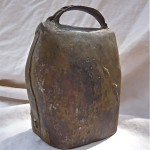Science and Environment
America in the Weeds
Most weed killers, whether for wheat fields or suburban lawns, work by disrupting the endocrine systems of plants. The picture that emerges in the snapshot reports linked below is that common weed killers also disrupt the endocrine systems of amphibians and may disrupt those of humans, too.
The Clopyralid series, also linked below, broke the story of wide-scale contamination of farming and garden compost by a Dow herbicide and led to the weed killer’s banning in many contexts, first in California, then nationwide.
- The War on Dandelions
- Atrazine, Wheat and Us
- Clopyralid
Antibiotics: Farm Tool or Medicine?
Apples: Organic vs. Conventional
 Built into a Corner: The Choking by Sediment of the Los Angeles Flood Control System
Built into a Corner: The Choking by Sediment of the Los Angeles Flood Control System
Chemists argue about Safety of Teflon while We All Use It
Concerning Cows, Sheep and Cannibals
 News reporters working in Britain in the 1980s and 1990s had to learn about livestock, particularly cattle and sheep. In 1986, a neuro-degenerative disease, long studied in sheep but theretofore unknown in cattle, appeared in dairy herds in the south of England. Soon cases of the cattle disease, formally named Bovine Spongiform Encephalopathy or BSE, and informally called “mad cow disease,” were diagnosed all over the British Isles and Ireland. A decade later, in 1996, BSE jumped species again, this time emerging in young Britons. Fifty million Britons had conceivably been exposed to it. The world’s press descended on the UK in what was the worst public health crisis on record. That year, against international competition, one of the reports posted here (see below, “A Cow & Bull Story”), won the Assn. of British Science Writer’s Award for best feature. It was followed by a systematically deployed barrage of articles in the New Statesman magazine between 1996 and 1998 that led to the then newly elected Labour government calling a public inquiry into the government’s handling of the disease.
News reporters working in Britain in the 1980s and 1990s had to learn about livestock, particularly cattle and sheep. In 1986, a neuro-degenerative disease, long studied in sheep but theretofore unknown in cattle, appeared in dairy herds in the south of England. Soon cases of the cattle disease, formally named Bovine Spongiform Encephalopathy or BSE, and informally called “mad cow disease,” were diagnosed all over the British Isles and Ireland. A decade later, in 1996, BSE jumped species again, this time emerging in young Britons. Fifty million Britons had conceivably been exposed to it. The world’s press descended on the UK in what was the worst public health crisis on record. That year, against international competition, one of the reports posted here (see below, “A Cow & Bull Story”), won the Assn. of British Science Writer’s Award for best feature. It was followed by a systematically deployed barrage of articles in the New Statesman magazine between 1996 and 1998 that led to the then newly elected Labour government calling a public inquiry into the government’s handling of the disease.
Below are a selection of pieces from that period, along with some follow up work done for the London Evening Standard, New York Times and Los Angeles Times. The report for the Los Angeles Times on the “mad sheep” of Vermont led to then Governor Howard Dean allowing the destruction of an infected flock owned by AIG millionaire Houghton Freeman.
- Mad Cows in Britain

- “Human BSE” Confirmed, Scientists call for Inquiry
- Agenda for the Public Inquiry into the Origins and Handling of BSE
- The Etymological Cow
- The Improved Cow
- Improved Rations for Improved Cows
- Who Knew What About Improved Rations
- Ministers Blunder, Mad Cow Disease Gets Away
- A Beheader’s Story
- About the Inquiry for Worried Americans
- A Deal Is Struck The Day Before the Public Inquiry Reports
- Mad Cows in the U.S.
- Mad Sheep in the U.S.
- M(b)ad Scientists in Britain and the U.S.
- A Cow & Bull Story: A profile of Harash Narang (winner of the 1997 Assn of British Science Writers Award for ‘Best Feature’)
- Same Mistakes All Over Again. Mad Cow to Foot and Mouth
- Vets Predict (Rightly) If Foot and Mouth Broke Out, They Couldn’t Handle It
- Trade Reasons, Not Science behind Refusal to Vaccinate
- Urban Fear, Rural Realities and Us
Dairies and Dairying
- Milk and Public Health in the UK
- Is Milk Still Milk in the US?
- The Man Who Saved Raw Milk in California
- Veal Calves in the UK
Do-gooders
E. coli O157
The Flora of North America Project
The Human Trial of Human Growth Hormone
The Mojave Desert Desecrated: Moving Tortoises for Military Bases, Casinos and Suburbs
Migration of the Monarchs
New Fruit
Pipeline: Chinatown, Nevada-style
Salt
Urban Farming



